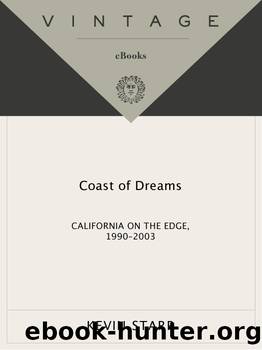Coast of Dreams by Kevin Starr

Author:Kevin Starr [Starr, Kevin]
Language: eng
Format: epub
ISBN: 978-0-307-79526-7
Publisher: Knopf Doubleday Publishing Group
Published: 2011-05-11T00:00:00+00:00
PART VII
A Tale of Two Cities
Los Angeles and San Francisco
People
In the aftermath of the April-May 1992 riots, an ad hoc group of Latino leaders, believing that the Latino future of Los Angeles was not being fully recognized in the Rebuild LA effort, organized the Latino Coalition for a New Los Angeles. Within the year, they issued a startling and prophetic report, Latinos and the Future of Los Angeles: A Guidebook to the Twenty-first Century (1993). Prepared by the Latino Futures Research Group and written and edited by UCLA professor David Hayes-Bautista, the document correctly predicted what had become obvious by 2002: the emergence of Los Angeles as a Latino city, the second most important Mexican city on the planet. The majority of Latino residents, the document insisted, did not participate in the riots; indeed, they were as horrified as anyone by the misbehavior and devastation. Los Angeles Latinos, the report argued, tended to be home-owning, churchgoing family people, believing and practicing a traditional conception of marriage and childrearing. Latinos were essential to the stabilization of Los Angeles, and they constituted the largest single matrix of reliable working people on whom could be based the rebuilding of what the report described as âa new and even grander city on the Pacific Shore, a twenty-first century City called Los Angeles.â
Seven years later, in his third thought-provoking book of the decade, Magical Urbanism: Latinos Reinvent the US Big City (2000), urbanist Mike Davis forcefully argued that such a new metropolis on the Pacific was showing every sign of having arrived. Far from deconstructing American cities, Davis pointed out, Latinos were creating a new urban matrix with a special proclivity for public life. The big urban story of the 1990s, Davis said, especially the big Los Angeles story, was how Latinos had brought to the abandoned inner city a vibrant street life and a passion for public culture. Far from being abandoned, downtown Los Angeles, the East Side, Pico Union, and even the South Central portions of the city were witnessing Latino immigrants in the process of repossessing streets, parks, playgrounds, public squares, public libraries, and other places previously left behind by white flight. Los Angeles, in short, was being reinvented in its central district as a Latino public place, and this process, occurring as well in Houston, San Antonio, Dallas, Phoenix, and San Diego, was restoring to the American city a public identity and civic value resistant to the debilitating provincialization that came from obsessive privatization.
For Joel Kotkin, the teeming Pico Union district was reprising New Yorkâs Lower East Side of one hundred years earlier, when equally embattled Jewish immigrants from eastern Europe had poured into the city and created a ghetto that bore within itself the possibilities of an eventual, and much more sophisticated, urbanism. Poverty and crime were evident in Pico Union, Kotkin admitted, but it also had to be recognized that in 1906 fully one-third of the juvenile delinquents in the childrenâs court of New York came from the Jewish immigrant population.
Download
This site does not store any files on its server. We only index and link to content provided by other sites. Please contact the content providers to delete copyright contents if any and email us, we'll remove relevant links or contents immediately.
Nudge - Improving Decisions about Health, Wealth, and Happiness by Thaler Sunstein(7255)
iGen by Jean M. Twenge(5166)
The Fire Next Time by James Baldwin(5024)
Adulting by Kelly Williams Brown(4239)
The Hacking of the American Mind by Robert H. Lustig(4092)
The Sports Rules Book by Human Kinetics(4079)
The Ethical Slut by Janet W. Hardy(4042)
Captivate by Vanessa Van Edwards(3732)
Mummy Knew by Lisa James(3522)
In a Sunburned Country by Bill Bryson(3374)
The Worm at the Core by Sheldon Solomon(3327)
Ants Among Elephants by Sujatha Gidla(3282)
Suicide: A Study in Sociology by Emile Durkheim(2908)
The Slow Fix: Solve Problems, Work Smarter, and Live Better In a World Addicted to Speed by Carl Honore(2843)
The 48 laws of power by Robert Greene & Joost Elffers(2816)
Humans of New York by Brandon Stanton(2690)
Handbook of Forensic Sociology and Psychology by Stephen J. Morewitz & Mark L. Goldstein(2605)
The Happy Hooker by Xaviera Hollander(2586)
The Tipping Point by Malcolm Gladwell(2563)
